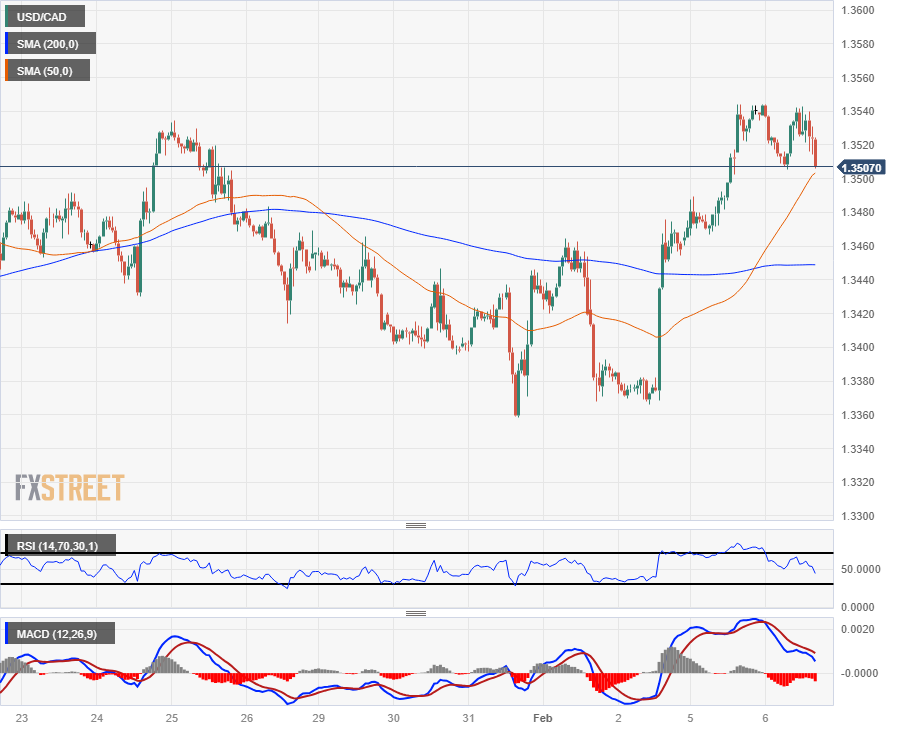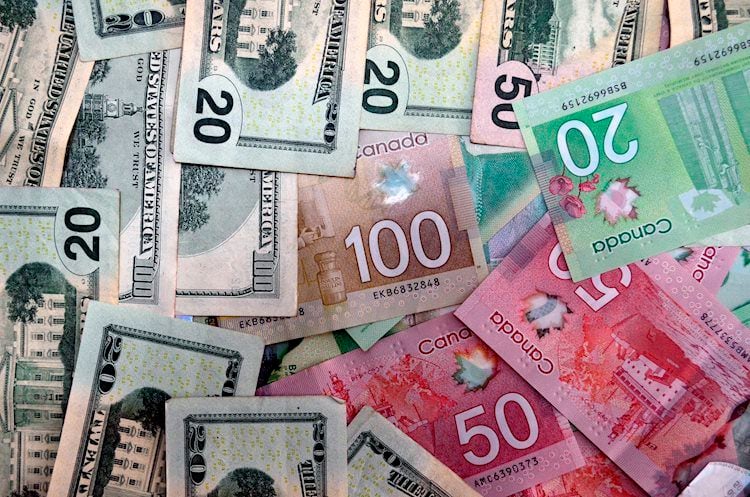- Canadian Dollar halts the slide but fails to recover ground.
- Canada’s PMI, Building Permits muddy the waters.
- BoC Governor Macklem due to speak in Montreal.
The Canadian Dollar (CAD) managed to pump the brakes on a two-day backslide on Tuesday, but a recovery seems limited as Canadian economic figures look mixed. Loonie bidders await Bank of Canada (BoC) Governor Tiff Macklem’s input. Governor Macklem will be giving a speech regarding the effectiveness and limitations of monetary policy at the Montreal Council on Foreign Relations at 18:00 GMT, but the speech text will be released at 17:45 GMT. BoC Macklem is expected to answer audience questions after the speech.
Canada saw a steep decline in the MoM Building Permits in December as well as downside revisions to the previous months’ releases, though the revision-heavy indicator is prone to having a muted impact. The seasonally-adjusted Ivey Purchasing Managers Index (PMI) for January ticked slightly higher, helping to offset any bearish trickles from Building Permits. Flat Crude Oil markets are also keeping the Canadian Dollar afloat but price action lacks momentum.
Daily digest market movers: Canadian Dollar takes a breather
- BoC Governor Macklem’s speech notes will be released at 17:45 GMT, Macklem expected to answer questions after 18:00 GMT statement.
- Canadian Building Permits declined 14% in December, far below the 1.2% expected uptick and the worst showing for Canadian Building Permits since last April.
- November’s Building Permits also saw a downside revision to -5% from -3.9%.
- Canada’s unadjusted Ivey PMI for January ticked upward to 54.4 from 43.7.
- The seasonally-adjusted Ivey PMI grew for a fourth straight month but was noticeably thinner at 56.5 versus the previous 56.3.
- Markets were expecting January’s adjusted Ivey PMI to decline to 55.0.
- Coming up this week, the Bank of Canada’s latest Summary of Deliberations will be released on Wednesday with wages and labor figures due on Friday.
Canadian Dollar price today
The table below shows the percentage change of Canadian Dollar (CAD) against listed major currencies today. Canadian Dollar was the weakest against the Australian Dollar.
| USD | EUR | GBP | CAD | AUD | JPY | NZD | CHF | |
| USD | -0.07% | -0.44% | -0.26% | -0.52% | -0.38% | -0.28% | -0.01% | |
| EUR | 0.07% | -0.36% | -0.21% | -0.45% | -0.33% | -0.22% | 0.06% | |
| GBP | 0.41% | 0.36% | 0.16% | -0.10% | 0.03% | 0.14% | 0.40% | |
| CAD | 0.25% | 0.20% | -0.16% | -0.25% | -0.12% | -0.02% | 0.26% | |
| AUD | 0.53% | 0.46% | 0.10% | 0.27% | 0.15% | 0.26% | 0.53% | |
| JPY | 0.38% | 0.32% | -0.05% | 0.14% | -0.17% | 0.11% | 0.37% | |
| NZD | 0.28% | 0.21% | -0.15% | 0.02% | -0.24% | -0.11% | 0.27% | |
| CHF | 0.01% | -0.07% | -0.42% | -0.27% | -0.52% | -0.38% | -0.28% |
The heat map shows percentage changes of major currencies against each other. The base currency is picked from the left column, while the quote currency is picked from the top row. For example, if you pick the Euro from the left column and move along the horizontal line to the Japanese Yen, the percentage change displayed in the box will represent EUR (base)/JPY (quote).
Technical analysis: Canadian Dollar finds flat ground as USD/CAD churns near 1.3500
The Canadian Dollar (CAD) is broadly mixed on Tuesday but looks upward. The CAD is down a quarter of a percent against the Australian Dollar (AUD) and a tenth of a percent against the Japanese Yen. The CAD is also up around a quarter of a percent against the US Dollar (USD) and the Euro (EUR).
USD/CAD drifted into a near-term ceiling at 1.3540 as the pair cycles near the 1.3500 handle. The pair climbed 1.33% bottom-to-top after the US Dollar rebounded against the Canadian Dollar late last week, and the CAD is looking for a foothold to make a recovery and drag the USD/CAD back below the 1.3500 level. This would be back toward the 200-hour Simple Moving Average (SMA) at 1.3450.
USD/CAD is struggling to maintain bullish momentum after breaking into the topside of the 200-day SMA on Monday, and the pair is at risk of getting dragged back into congestion between 1.3476 and 1.3426 as the 200-day and 50-day SMAs consolidate.
USD/CAD hourly chart
USD/CAD daily chart
Canadian Dollar FAQs
The key factors driving the Canadian Dollar (CAD) are the level of interest rates set by the Bank of Canada (BoC), the price of Oil, Canada’s largest export, the health of its economy, inflation and the Trade Balance, which is the difference between the value of Canada’s exports versus its imports. Other factors include market sentiment – whether investors are taking on more risky assets (risk-on) or seeking safe-havens (risk-off) – with risk-on being CAD-positive. As its largest trading partner, the health of the US economy is also a key factor influencing the Canadian Dollar.
The Bank of Canada (BoC) has a significant influence on the Canadian Dollar by setting the level of interest rates that banks can lend to one another. This influences the level of interest rates for everyone. The main goal of the BoC is to maintain inflation at 1-3% by adjusting interest rates up or down. Relatively higher interest rates tend to be positive for the CAD. The Bank of Canada can also use quantitative easing and tightening to influence credit conditions, with the former CAD-negative and the latter CAD-positive.
The price of Oil is a key factor impacting the value of the Canadian Dollar. Petroleum is Canada’s biggest export, so Oil price tends to have an immediate impact on the CAD value. Generally, if Oil price rises CAD also goes up, as aggregate demand for the currency increases. The opposite is the case if the price of Oil falls. Higher Oil prices also tend to result in a greater likelihood of a positive Trade Balance, which is also supportive of the CAD.
While inflation had always traditionally been thought of as a negative factor for a currency since it lowers the value of money, the opposite has actually been the case in modern times with the relaxation of cross-border capital controls. Higher inflation tends to lead central banks to put up interest rates which attracts more capital inflows from global investors seeking a lucrative place to keep their money. This increases demand for the local currency, which in Canada’s case is the Canadian Dollar.
Macroeconomic data releases gauge the health of the economy and can have an impact on the Canadian Dollar. Indicators such as GDP, Manufacturing and Services PMIs, employment, and consumer sentiment surveys can all influence the direction of the CAD. A strong economy is good for the Canadian Dollar. Not only does it attract more foreign investment but it may encourage the Bank of Canada to put up interest rates, leading to a stronger currency. If economic data is weak, however, the CAD is likely to fall.
